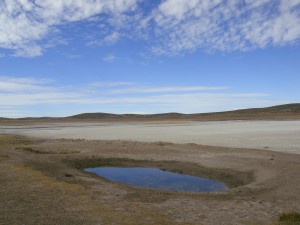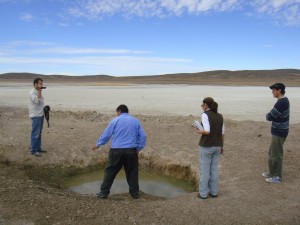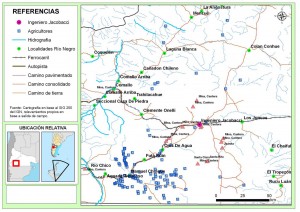Interdisciplinary science and development integration for adaptation to water scarcity in the Comahue region, Argentina (CRN 3102)

Project information
Programa de Investigaciones sobre Recursos Naturales y Ambiente, Instituto de Geografía, Facultad de Filosofía y Letras, UBA (Argentina)
Results
This is a summary of the most salient project results. For further information see the project website, project papers or contact the investigators directly.
The project conducted a meta-analysis of collaboration among investigators and stakeholders as producers and users of information in an internationally funded project in Argentina. Primary data sources are: interviews, participant observation, surveys, workshops, visits to producers. Secondary sources: institutional reports, newspapers, national and provincial governmental data (INDEC, AIC, INTA, INAI), audiovisuals and cartography.
Social Network Analysis showed the interactions between project components and also their territorial focus. Metrics such as node centrality (degree, betweenness and closeness) and coefficients of clusterization showed that after an initially cohesive proposal, the project fragmented into model-based prospective studies on hydroelectric and other water uses and, on the other hand, data collection and practical interventions for community development in an arid region.
Ethnographic exploration of the role of “institutions” revealed groups represented by the commitment of an expert in the field of decision making, which are involved in the scientific project. This does not necessarily represent the (political) interests of the institution despite having the formal (contractual) endorsement by it. This may be typical of global change or sustainable development – oriented projects that do not fit the core mandates of academic institutions.
Scientific institutions that normally generate information for themselves, in this project were requested to provide data. In this development research, important boundary functions needed to be filled – coproduction of knowledge; statistical measures adapted to institutional needs (e.g. measures of uncertainty); and local knowledge and partnerships. This need was filled by individuals with partnership or membership in a research center and a professional local cooperative.
Such actors with double institutional role contribute to the link between science and public and private policy. They include technical officials of external institutions involved with the project. They supported the coproduction of knowledge and the participatory formulation of water policy. Decision makers and potential users assumed the roles of information providers, and testers of the feasibility of its application in public resource management.
Although one project component focused on vulnerability, its definition remained underdeveloped, partly because different definitions related to the social (social vulnerability) and environmental realms (climatic vulnerability, flow sensitivity). The research component on mitigation took “vulnerability” for granted and associated with “those different”, who “needed external help”, “inevitably coexist with catastrophes” in “poverty”. From this point of view, the perspective of “difference” and “necessity” produces actions to mitigate persistent threats of arid environments (“water scarcity”), but performed as “climatic change mitigation and adaptation”. Despite this misrepresentation, any resulting intervention within communities becomes a concrete contribution to solve real-life problems of rural cooperatives.
Despite well-known difficulties in the qualitative-quantitative data processing, communication flow between researchers of social and environmental disciplines was not sufficient resulting in serious communication problems and deficiencies in theoretical model building. Models and cartography provide boundary objects. They are core to intersectoral communication and scientific decision making on the type of data needed, thresholds and projections. Here, negotiation is central to the use of knowledge, with a great emphasis on complex knowledge building and interdisciplinary and intersectoral decision making.
Students
Luciano D’Fabio, Undergraduate, Universidad de Buenos Aires, Argentina.
Martin Kazimierski, Undergraduate, Universidad de Buenos Aires, Argentina.
Executive Summary
We will examine the design and progress of a successful interdisciplinary science and development project (by IDRC and Fundación Bariloche), document how the challenges of interdisciplinary and intersectoral work are met, and how progress is shaped by the needs to solve real problems of development and adaptation to global change. Our team will collaborate with the existing project on water security, working both with project scientists and engineers and with government and civil society to map research, development and decision making processes.
Using in-depth, open interviews, progress reports and government documents, our team will study the managerial, communication and capacity building aspects of co-design strategies used for research and technical management, and decision making at several governance levels. The aim is to reveal a practical scheme of interaction and feedback between investigation, development actions in the field, and institutional and community needs and responses. Results of this investigation will serve as a guidance to scientists and institutions of science governance towards improving the generation and mobilization of interdisciplinary knowledge and resulting development interventions.
Download PPT
Photos



